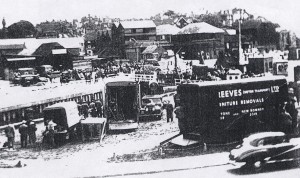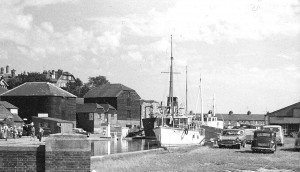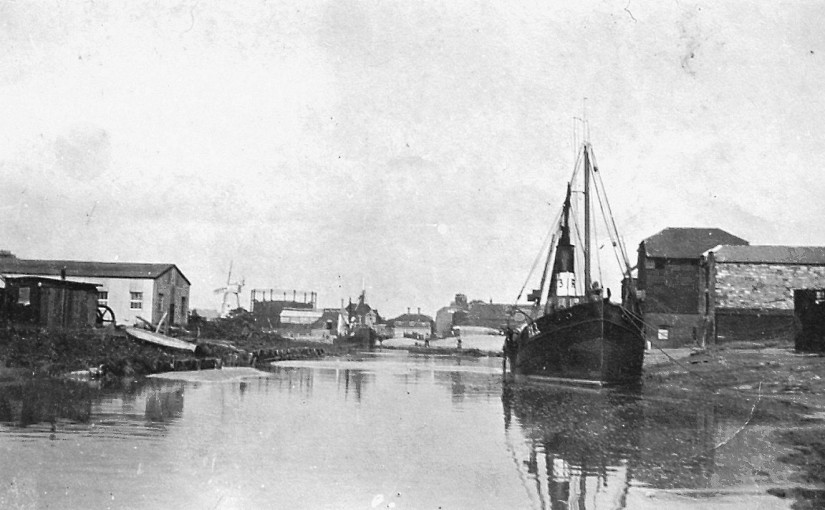The Strand
Part Three
By Arthur Woodgate
As the Strand emerged from War time the scene was not quite what we had been used to, but apart from Strand House and its cottages and Havelock Villas not being there, it was not as bad as one would expect. The timber stacks were still there, and in fact had extended into the space left by the bombed houses and offices, and so they remained into the 60s. The amount of commercial shipping was being replaced by Leisure Craft. The Wheelwright shop, which had a Wish Street address, had its side along what is now the Strand Cafe, had been running down up until the start of the Second World War, had lost its little “Village Green” like ground with old wheel and pieces of carts and its space where wagons had been built, had gone. But the road entrance leading to the “Pipe Makers” car park, which had replaced a small path leading to Jarretts Herring Dees, which had gone out of use, was still there in spite of being close to Havelock Villas. Timber was still rationed and the builders were getting desperate to complete the enormous task of repairing the bomb damage left everywhere. It is a reflection on those times that even with all that timber so exposed. there was no serious case of theft. The stocks seemed to increase and a wall was built where Havelock villas had been, for stacks to be extended behind it. Rumours were about that it was a land grab, but it was done through squatters rights.
The Joinery Works had increased and found jobs for several joiners, because of the World War damage which was considerable throughout the area and expanded as rationing eased. Later, within a few years of each other, the Hinds family died out and the business was bought by Alfords who still had a presence on the Strand into the sixties, but eventually moved to new wharves on the Rother where they could have bigger cargos.

Most people will have read or seen the film of Dunkirk, some of which was made at the Strand in 1957, but not so many will have heard about the real drama that happened during the filming. The front bedroom of my fathers house was a good vantage point to watch the strand being turned into a French town. As we watched the film extras, acting as refugees, crossing the temporary bridge that had been built by the film company, we saw a car reverse over the quay into the river which was fairly full of water at that time. One of the camera men saw this too, and dived from his gantry into the river and pushed the driver and passenger out and brought them to the surface from where they were pulled to dry ground by onlookers. Being a member of St. John, I ran to the site where I found one or two of our members and firemen already there. The firemen were having some success in bringing the woman round, but our lads, although they had the circulation back in the man they just couldn’t’ get him to breath one of our ambulances was brought round and we carried on resuscitation whilst loading the man into the vehicle. We took him up Rye Hill to Rye Hospital where he was put on the operating table and continued with the rocking stretcher method or artificial respiration. Although, by now; there were several doctors about. We were unable to save him, because his neck was broken. Meanwhile, the camera man was taken into our house and had his cuts and bruises seen to and a drying out and general clean up. A real hero! but never recognised, as such brave people seldom are.
This was the third tragedy, as there were two more in the twenties. I said earlier that it was amazing that not many of our Mermaid Street boys had been drowned. It was one, Dennis Pawsey who fell in on his way to his home in Winchelsea Road. There were no demands as I can remember for the quay to be child proofed, but there is no doubt, by the last decade of the 1900s there would have to have been something done, which, of course has happened to some degree, by improvements to the Strand in general. The other tragedy and perhaps the worst at that time and at that point was when Mr. Care, a member of a freighter crew and a Ryer, was up in rigging, doing some adjustments when he fell, hit the deck and broke his back. He spent the rest of his life in the Rye Workhouse. At around the same time a Miss Scott, daughter of a wealthy broker of Pelsham, fell off a hunter and also broke her back. She was fitted up with a spinal carriage and a private ambulance, and when we built the first Regent Cinema some of the seats had to be left for easy removal to let her spinal carriage in. As I remember there was some outcry about this, but nothing much happened. By the end of the century Mr. Care would have been treated much better with laws covering injuries at work.
In 1964 a low brick wall was built along the river, so now one knew the Quay from the Strand road instead of the previous uncertain and untidy boundary. Then gradually the warehouses were changed in use but not in character, and the site of the Strand cottages was built up in an attempt to keep the Strand character too and a very good job was made of it.

BUT! when the property developers got hold of the deals it was rather different as the familiar stacks of sawn deal and sheds of prepared deal and mouldings we have a mass of red bricks of apartments, shops, and information. SO! where we once bought carcassing timber we now get information where we once bought joinery we now go into a road to housing and where we once bought architrave and other mouldings we are now weighted down by a big anchor; far too big for any craft that came up the Strand. I would think.
Where lumps of aggregate once were, we now have hard surface where visiting motor cycles rest whilst running about the A259, which the Strand is so smart a part of now. Where sailing ships and steam trawlers once tied up there are leisure boats.
I have tried to make this not like a catalogue of events, but rather my memory of happenings both seen and heard between 1900 and 2000 regardless of sequence, just as I have thought about it.
I am leaving behind a Strand not as picturesque or romantic as in my youth but I wish those who have to live with it in the 21st Century every success.
From Rye’s Own November 2004
